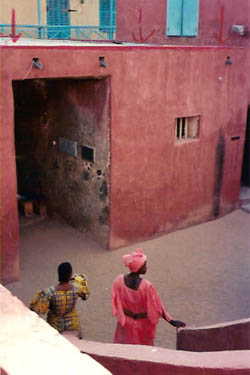 <a onClick="window.open('/olcweb/cgi/pluginpop.cgi?it=jpg::::/sites/dl/free/0073511935/234798/W8_4.jpg','popWin', 'width=NaN,height=NaN,resizable,scrollbars');" href="#"><img valign="absmiddle" height="16" width="16" border="0" src="/olcweb/styles/shared/linkicons/image.gif"> (23.0K)</a> <a onClick="window.open('/olcweb/cgi/pluginpop.cgi?it=jpg::::/sites/dl/free/0073511935/234798/W8_4.jpg','popWin', 'width=NaN,height=NaN,resizable,scrollbars');" href="#"><img valign="absmiddle" height="16" width="16" border="0" src="/olcweb/styles/shared/linkicons/image.gif"> (23.0K)</a>
Bharati Sadasivam
The first slaves were taken from Gorée in 1536. The slave trade continued until 1848. | A group from Freeport plans to travel to Gambia and Senegal next month to visit areas in which their ancestors lived. In the itinerary is a visit to Gorée Island in Senegal that was one of the major shipping points in Europe's trans-Atlantic slave trade. For three centuries, Africans were taken to Gorée for shipment, some branded like cattle, the rebellious chained to a 17-pound weight or placed in neck and leg chains. Families taken to Gorée were broken up; the mother may have been shipped to South America, a child to America, the father to the Antilles.
In the American slave trade, run mostly by traders from Massachusetts and Rhode Island, ships left American ports with rum and returned with shiploads of slaves. A male slave sold in the Southern states brought 60 English pounds by mid-18th century, and slave importation was so profitable that two-thirds of the ships sailing from Rhode Island ports were engaged in the slave trade. By 1770, 450,000 slaves were at work in the colonies.
Matthew Bennington Rogers, 985 Millbank Rd., who will lead the tour, said the tour is an attempt to establish "a connection with our past, our past as Africans."
"When Nelson Mandela went to Gorée after his release from prison," Rogers said, "he sat in an isolation cell used to punish rebellious slaves. He was there for five minutes and emerged shaken and red-eyed. He understood."
Pope John II also visited and apologized for the slave trade and asked forgiveness for those who had participated in the trade, including Catholic missionaries, who accepted the situation.
With background material, write 300 to 400 words. |

